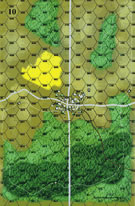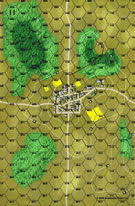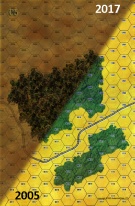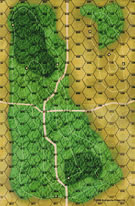|
Demyansk Pocket Sinister Forces #22 |
||
|---|---|---|
| (Defender) Germany | vs | Soviet Union (Attacker) |
| Formations Involved | ||
|---|---|---|
| Germany |  |
3rd SS "Death's Head" Division |
| Soviet Union |  |
202nd Rifle Division |

|
| Overall Rating, 4 votes |
|---|
|
2.5
|
| Scenario Rank: --- of 957 |
| Parent Game | Sinister Forces |
|---|---|
| Historicity | Historical |
| Date | 1942-01-08 |
| Start Time | 10:00 |
| Turn Count | 30 |
| Visibility | Day |
| Counters | 118 |
| Net Morale | 1 |
| Net Initiative | 3 |
| Maps | 4: 10, 11, 6, 9 |
| Layout Dimensions | 86 x 56 cm 34 x 22 in |
| Play Bounty | 149 |
| AAR Bounty | 154 |
| Total Plays | 3 |
| Total AARs | 3 |
| Battle Types |
|---|
| Inflict Enemy Casualties |
| Surprise Attack |
| Urban Assault |
| Conditions |
|---|
| Off-board Artillery |
| Severe Weather |
| Scenario Requirements & Playability | |
|---|---|
| Battle of the Bulge | Maps |
| Eastern Front | Maps + Counters |
| Sinister Forces | Base Game |
| Introduction |
|---|
|
When Northwestern Front opened its "Staraya Russa Operation" in early January, 1942, it quickly met success. The German 30th Infantry Division gave way before 34th Army's wing of attack, as the Red Army shredded the German lines and plunged toward their first objective, Beglovo Station. Occupying a reserve position behind 30th Infantry, the SS Death's Head Division had not expected to be committed to combat. Though alerted to move forward and support the regular army unit, the SS division had not yet responded when Soviet troops poured into its camps. |
| Conclusion |
|---|
|
German reports identified elements of 21st Tank Division fighting alongside 202nd Rifle; Soviet accounts do not support this and the SS staff were eager to find excuses for their collapse. However, 21st Tank would be dissolved at the end of February and 202nd Rifle clearly fielded some mobile elements in its attack. The SS suffered serious casualties as the responded only slowly, with units till failing to respond long after other division troops had come under attack. Having lost most of its transport, the SS division reeled away to the south, where it would spend the next five months trapped in the so-called "Demyanks Pocket." |
| AFV Rules Pertaining to this Scenario's Order of Battle |
|---|
|
| 3 Errata Items | |
|---|---|

|
All SS 75mm IG guns are direct fire weapons (black), not indirect (white). (Shad
on 2010 Dec 15)
|

|
The reduced direct fire value in Kursk: Burning Tigers is 4-4. (plloyd1010
on 2015 Jul 31)
|

|
Kommissars never get morale or combat modifiers. Ignore misprints. (Shad
on 2010 Dec 15)
|
| An Exciting Battle - (But sort out two errata beforehand) | ||||||||||||||
|---|---|---|---|---|---|---|---|---|---|---|---|---|---|---|
This scenario was played over 2 x ftf sessions with Wayne Baumber and was chosen via our usual random selection procedure. When I looked at the game, I knew as the German that it would be one to enjoy historically rather than worrying about winning. However, as it turned out, despite the lack of forces to be able to move freely for 15 turns of a 30 turn battle, it turned out as a surprisingly close affair ! I would recommend before play that 2 pieces of errata are sorted in relation to the rules used. 1.What movement costs are you going to charge units to move through rail hexes ? One MP or the terrain in the hex. The SSR's do not say. 2.What is railroad ? SSR's state the east-west road is railway. Unlike Fronte Russo, it does not say that the town hexes are rail also. Therefore, this leaves just the 'road' hexes to move on. I took it as this, Wayne took it that the town could be used. Maybe there is no errata here, but it would have been nice if SSR's were specific here and on the MP cost too. ACHTUNG ! An interesting special rule is that German units can not move or fire unless an enemy unit moves adjacent or a unit is fired on, then any units within 2 hexes are released to move etc. However, at the start of each initiative when Russkies are first spotted, an 'Achtung' roll can be made using 2 x dice. If 11+ is rolled, all German units can move and fire normally. I didn't get it till turn 16 ! SET-UP OPTIONS Difficult this. I tried to set-up so the Soviets will HAVE to come in sight soonest ossible and therefore give the Germans the chance to roll 'achtung 11+' as early as can be. The Germans will also need to consider either a flimsy linear defence but with the advantage of the enemy always 'alarming' some units wherever they move OR solid 7 hex honeycombs, but with gaps. I went with the latter so that when attacked, each 'gruppe' could at least support all its own components. The Germans are also limited to putting 'minimum' 15 units on EACH of the 4 boards INCLUDING trucks. Given that there are 28 trucks, you can see how the groups will become very flimsy indeed. *** IMPORTANT NOTE *** Remember in Sinister Forces all woods are normal woods, there are NO light woods. Anyway, heres the resume of the battle itself. TO BATTLE The SS units here had set up in four separate ‘honeycombs’ all far separated from each other. One was set in Beglevo itself. Then one far to the south of Beglevo in the forest areas comprised mainly of ordnance and transports (who’d probably need to escape) and two honeycombs far to the east and right in the path of the oncoming Soviet advance. However, they had deployed so that any Soviet incursion would immediately give the chance of the ‘Achtung’ order getting out as early as possible. If the Germans were to claim some kind of victory, they would need to hold the town of Beglevo and make sure most of their supply trucks escaped to the south. As expected, Soviet moves and attacks alerted the first units in the northeast. Despite attempts to get the stand=to message out (11+ on two dice), no message was received division-wide at least for the first 4 hours (15 turns). This had the effect of stymieing any chance of German counter-moves to halt the attack. For 2 hours, German losses were very low in the east side of the battle as the Soviets had only managed to overrun two AT batteries. This had cost the Soviets one MG platoon. What the Soviets had done though was to manoeuvre into very useful attack positions without receiving any opposition. At 1245 hours, the 202nd Rifle Division attacked in earnest against the SS east-side positions. Over the next two hours, the German units were cut down and eliminated almost completely. Only one motorcycle platoon and a company of infantry were in a position to attempt a retreat towards Beglevo. Some of the Germans held out well, holding up the enemy for nearly an hour, but they too eventually fell. Of the escapees, the motorcycle unit made it away, but the company of infantry soon became embroiled in close combat and assaults with the numerous enemy. These would hold out till around 1515 hours (turn 22), but like those before them, were overrun. The ‘achtung alarm’ was finally sent out at 1345 hours (turn 16) and the remaining third of the German forces spent their time readying themselves for the inevitable attack on Beglevo town. Soviet tanks, an armoured train, cavalry and infantry began the final advance. The attack here was a far more difficult affair for the Russians and this time they were having to absorb casualties during the attack. A large fight developed all round the town as the Red Army threw itself at the hemmed in defenders. By now, any remaining transports, just over half of them, had escaped to the south, meaning that this final battle around Beglevo would decide the days outcome. The Germans needed to hold on to a substantial part of Beglevo and fought hard for ownership of the town. However, firepower from the train and accompanying tanks made the first holes in the towns defences as they forced back German MG teams from the town’s edge. At the same time, the other Soviet attackers were forcing themselves into parts of Beglevo. This whole battle was costing both sides many losses and their cohesion. But the Soviet numbers and higher morale were to make the difference. They were able to enter most of the town and even if not all areas were cleared, the German counter-attacks failed to remove the Soviets. At game end, German casualties were large. 31 steps of infantry, 13 transports, and 2 AT platoons for a total of 46 steps inflicted when 45 were needed. Soviet casualties came to 9 infantry steps, 2 AFV steps, and 1 cavalry step for a total of 14 steps. But the Germans, needing to control 6 hexes of town to tie the battle only managed to hold 2 of their own, and probably would have only owned 1 if the last turn had been played. 5 town hexes were disputed. Soviet major victory. For me, this battle rated a '3' officially, but personally a '2', but only because of the miserable 'achtung' order not going out. It was horrid watching for 15 turns as the Soviets meandered into position, and I was not allowed to do anything meaningful. It hurt even more, that when it came to the end game, an earlier achtung may have saved 2 or 3 turns of final combat and perhaps a better result for the Germans. But this game, due to its variables can have any of the sides win. Not a bad bit of entertainment. |
||||||||||||||
| 0 Comments |
| Great solo scenario | ||||||||||||
|---|---|---|---|---|---|---|---|---|---|---|---|---|
In this scenario a strong Soviet force of decent morale supported with tanks, cavalry, light OBA, and even a train ambush a German SS force with lower morale with activation restrictions. Germans can only activate if a Soviet unit moves adjacent, fires on a unit within two hexes, or if a general alarm goes off (11 or 12 on two dice rolled during initiative phase). The Germans are limited to 15 units per board, two units per hex, trucks included. Victory is based on German losses. Thirty steps (trucks included) is a minor Soviet, 45 is a major Soviet, neither is a German minor, and holding six town hexes is a German major. Germans can exit off the south edge, but heavy snow decreases movement. Germans set up fourteen units on each board in a seven hex cell, to include seven trucks. They hold both towns. The east boards have Inf and HMG units, plus one 37mm each. The southwest board has Inf and the Krad, while the northwest town has mortars, the IG, the engineers, and Inf. With few leaders the Germans cannot afford to be spread out. The Soviets split into two main forces containing everything but the tanks, cav, mortars, and train. The train goes with the north force, the mortars with the south, while the tanks and cav make up a mobile force. The Soviets spend nine turns maneuvering into position, with the eastern German forces half surrounded, to include cutting the north south road, while the mobile force gets into position between the southwest force and the south board edge, cutting that road. On turn 10 the Soviets close adjacent to the eastern German forces while the tanks open fire on trucks and the cav charges into a German Inf. The tank attacks are successful while the charge kills the Inf. German return fire is not highly effective in the east, but the cav is shaken by adjacent German fire. At the start of turn 11 the general alarm goes off, allowing all German units to activate! In the northeast the position collapses fairly quickly. Several trucks pull away as the infantry forces delay the Soviets, but all but three steps of combat units are eventually eliminated. In the southeast the position holds a bit longer, but also eventually collapses. With no road to move west everything in that force is eventually eliminated. The Soviets pay a heavier price, but they can afford it. The Germans are being forced into a decision, try to escape or hold the town. With all roads south blocked the Germans determine going for a major victory is a better chance. In the southwest the tanks rip apart trucks, but the Germans managed to send the cav force into demoralization, which will take some time to recover. The force eventually pulls together and most of it moves north to the town. The Soviets realize their efforts to stack up step losses has put them in jeopardy of leaving the Germans in possession of the town. They now do everything they can to get forces ready to contest the town. They get forces into the area and begin their attack. After turn 26 (of 30) the Germans have lost 43 steps, but hold nine town hexes. By the end of turn 27 the count is 45 (major Soviet!), but the Germans still control eight town hexes. Turn 28 ends with 46 steps and seven town hexes. Turn 29 ends with 47 steps and the Germans still controlling six town hexes. Finally, after a heavy fight, on turn 30 the step loss count reaches 49 and the Germans are left holding only five town hexes for a major Soviet victory! Final losses were Germans: 3 leaders and 49 steps; Soviets: 1 leader and 14 steps. This doesn’t seem like a great scenario to play the Germans, and normally I rate based on whether the scenario is good for face to face. While the German player would have some chance to pull this off, it wouldn’t be fun to see your force get rolled. This would normally mean a rating of 2. BUT, in this case I have to say the scenario was just way too much fun to only score it a 2! Plenty of combat, a close ending, tanks, cavalry, and a train, this is just way too much cool toys not to get a score bump! If it had been a good two player option it’d get a 4 or 5, but in the end when it all balances out I gave it a 3. I highly recommend it for solo play! |
||||||||||||
| 0 Comments |
| Sloppy Scenario Special Rules mar victory | ||||||||||||||
|---|---|---|---|---|---|---|---|---|---|---|---|---|---|---|
This scenario was played over two FtF sessions with Vince Hughes. This looks like a very tough scenario for the Germans at first glance as they have lower morale, tough set up restrictions and need to roll an 11 or more to avoid the penalties of the "Surprise Rule" which in effect mean the the SS sit in their camps while the Soviets have free movement to encircle them at will. There are three problems with this scenario :
Anyway on to the battle, Vince's set up was just about the best the Germans can do given the severe restrictions on them, he had assured that I would hit a defending unit in the first turn therefore letting him start his "Achtung Roll" ASAP. My plan was to not worry about the alarm being raised but encircle the first two groups of SS and eliminate them picking up the 30 steps needed for a minor win then hotfooting tot he town and putting enough units into assault to deny the control of the town to the Germans. This plan worked but only just, I had great fun at the start letting the Cossack's saber down trucks and doing two small encirclement's there was some tough German resistance at on point but that was soon overwhelmed and of course good old Vince did not roll his alarm roll until halfway through the game. The endgame was quite tense could I get enough units across to the town, every game turn from about GT17 I went through conflicting emotions thinking at first that I was going to do it easily, then no I was going to fall short. As it happened from GT27 I realized that I had just got enough troops into the town to ensure a major win. Strange scenario this, the first half is a Soviet romp and all the German player can do is react, once he can move freely he has to make his mind up to either flee or make his stand in the town. Our game went down almost to the end and was reasonably exciting. However I have marked the scenario down because of the points made above. If playing this one with an opponent make sure you agree on where the railroad is and what are its MP costs. |
||||||||||||||
| 0 Comments |

 SiFo021
SiFo021 































